From Steve: Yet another cool Guest contribution! I have been down and out the last two days (sick) so these guest articles have been a huge help. By the end of the week I should have my Pentax K5 review up so stay tuned! Enjoy!
–
Using The Sony NEX-5 with Leica Lenses
By Paul Barclay
I have been following this site daily for the last several months and decided to buy the Sony NEX-5 camera with 16mm kit lens based on Steve’s Arizona State Fair photos and the links to other images made using Leica lenses. Once I received both the camera and lens adapter, and had the battery charged, I set off to a boat dock near where I work to make a few images to see how things work and possibly get an image worthy of a daily inspiration. I knew going in that the Sony lens was not the sharpest, but I was not prepared for the disappointing results I got from my Zeiss and Leica lenses.
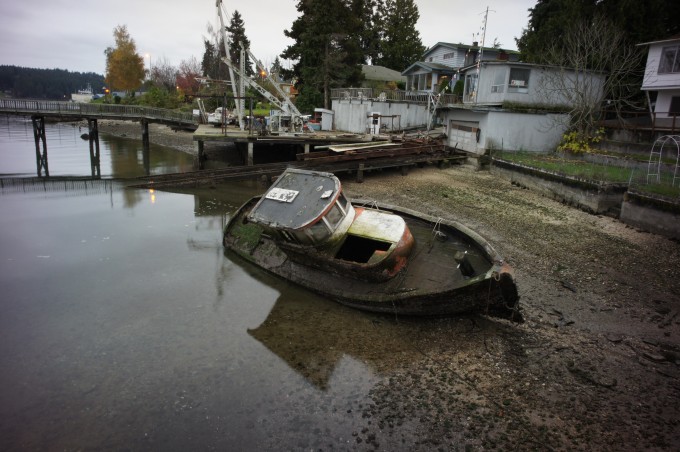 IMAGE #1 – Sony NEX-5 and the Zeiss 25 ZM Leica Mount lens
IMAGE #1 – Sony NEX-5 and the Zeiss 25 ZM Leica Mount lens
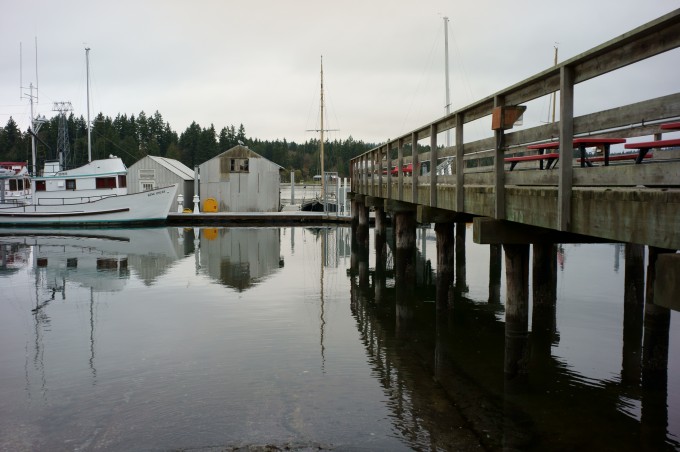 Image #2 – Sony NEX-5 and the Zeiss 25 ZM Leica Mount lens
Image #2 – Sony NEX-5 and the Zeiss 25 ZM Leica Mount lens
Image #1 is one of these images and as you can see it is a little soft. I went back the next day because the light was better and I would have more time to put into focusing the camera. Looking at the second set of images, some of them were better but not all. Image #2 was also taken using my Zeiss 25mm f2.8 ZM lens. The first impression of this image is it is better than the images from the previous day, but when enlarged to 100% it is not as good as hoped for from a Zeiss lens. Because of these results I decided it was time to go into the studio (a.k.a. garage) and make the dreaded test target shots to try to find out what is going on. I won’t bore everyone with these images, but I did learn some things that may be helpful to anyone interested in a Sony NEX-5 camera with lenses from other manufacturers.
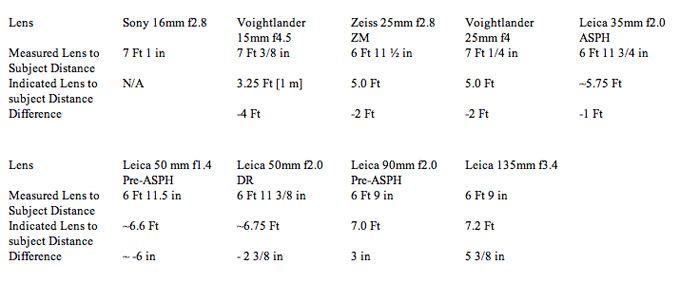
First, the tables below show that my Rainbow NEX-Leica lens adapter does not position all lenses at the correct position in front of the sensor. In my test shots I set the camera on a tripod at a fixed distance from the test target, measured the distance from the front lens element to the target then focused optically using the focus assist; I focused the Sony lens both using the camera and manually. For lenses with an actual focal length 50mm and wider it is necessary to focus closer than the actual distance to the subject, and this adjustment increases significantly as the lens gets wider. For lenses longer than 50mm the adjustment would be to focus farther than the actual distance, but this adjustment is so small it won’t be worth the effort. Since estimating the distance to a real subject won’t be that precise. It may be that the adaptor manufacturer decided that the ideal lens for most users is a 50mm lens or longer, or there may be some variation in the camera and adapter mounting distances working together. So it will be worthwhile for a wide-angle user to test their lenses on their camera to learn what adjustments are needed for their camera and adapter combination.
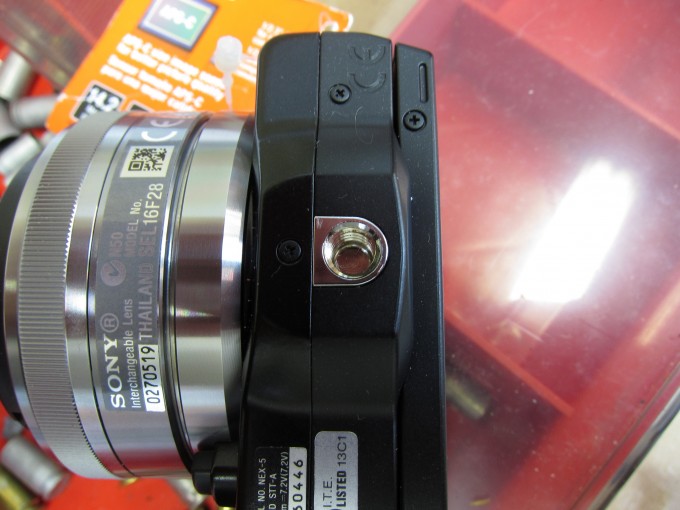 Image #3 showing the base of the Sony NEX-5
Image #3 showing the base of the Sony NEX-5
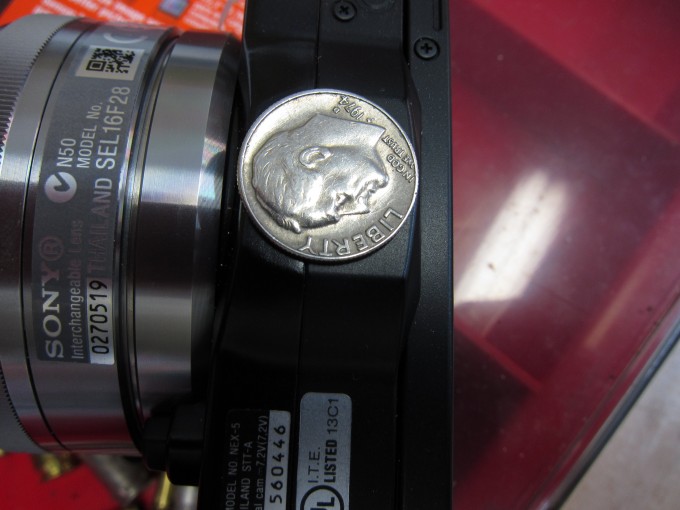 Image #4 – The Size of the Tripod Mount
Image #4 – The Size of the Tripod Mount
Since I generally want to maximize image sharpness and I also use large format equipment, I prefer to use a tripod for most of my photography. Unfortunately, as image #3 shows, the base of the NEX-5 is not flat. It is “V” shaped where the lens mount meets the base with the portion holding the tripod socket extending below the rest of the base by about 1/8 inch. Due to how narrow the base is this gives us a flat surface to rest the camera on a tripod about the size of a dime. (image #4) Which means that if the camera is on a tripod it will be very easy to rotate the camera and change your image composition and not notice it. It also means that the camera can be very prone to vibrations from shutter bounce, which is possible since this camera is very lightweight and does have a noticeable “bump” when the shutter closes, opens, and closes again during an exposure. In this case I think it might be desirable to use the camera hand held unless a dedicated adapter plate is available from one of the specialty manufacturers. Even with a dedicated adapter plate it will probably be desirable to keep both hands on the camera body to dampen the vibrations.
Manual focus is a challenge with 50-year old eyes and wide-angle lenses, even on a tripod. This is caused by the low magnification from the lenses and the small size of the rear LCD screen. Add in bright light and the value of an LCD shade or accessory viewfinder (either an electronic finder or a finder that uses the rear LCD) becomes apparent. As expected, manual focus gets easier with longer lenses since magnification is increased. Now that I have a bit more practice, manual focus is almost easy provided that you can see the screen, your subject has a pattern that is easy to see, and you hold the camera steady enough. I have found it easier to hold the lens with my left hand over the top and my thumb under the lens, on the focus aid if the lens has one. This gets my left arm out of the way of the back of the camera and lets me hold the camera out far enough to see with my glasses. In addition, this lets you use your left hand to support the weight of the camera and focus using the camera’s first manual focus assist feature. When you have achieved focus, pressing the shutter release half way will reset the screen to normal so you can adjust the composition before making your exposure. So far, trying to use the exit button just causes me to move the camera and shift the focus on the lens. So doing anything to reduce your hand motions is a good thing.
Finally, there is good news to share from these experiences. First the Sony 16mm lens is better than it is given credit for. Its optical focus limit is probably close to 10-12 Ft, and the test images looked pretty good up to 50% enlargement; at 100% the lens is still a little soft. Though I do get better results viewing J-Peg images on a PC using the Windows viewer or using iPhoto09 on a Mac, rather than using the Sony software on a Mac; Capture One does not convert the NEX raw files yet. Second, as the remaining images show, using Leica, Zeiss, and Voightlander lenses will provide very good results once you have a chance to practice your focus and distance estimating techniques. Even when used handheld at ISO 800, which includes many of the images shown here.
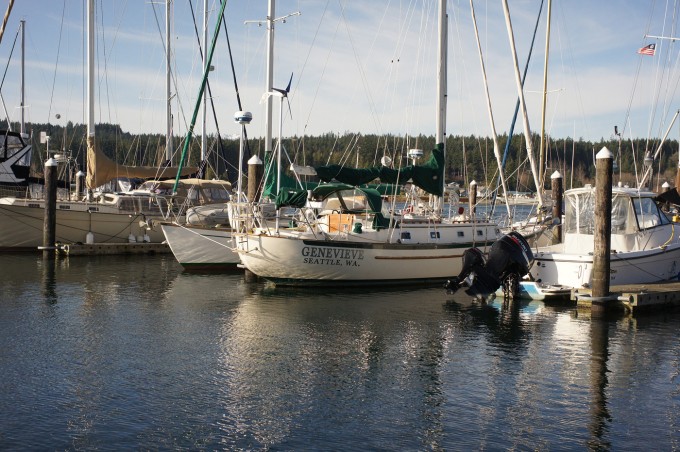 Leica 35 Summicron and the NEX-5
Leica 35 Summicron and the NEX-5
 Leica 35 Summicron and the NEX-5
Leica 35 Summicron and the NEX-5
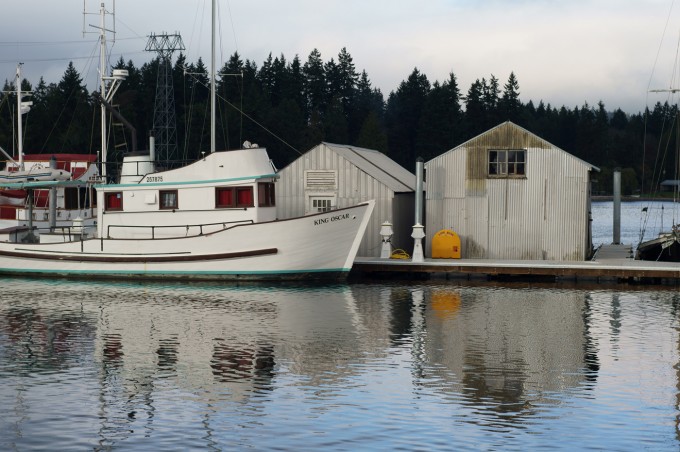 Leica 50 Summilux Pre-ASPH and the NEX-5
Leica 50 Summilux Pre-ASPH and the NEX-5
 Leica 135 f/3.4 and the Sony NEX-5
Leica 135 f/3.4 and the Sony NEX-5
So, in conclusion, the NEX-5 is a worthy experiment at this time. But it will need some aftermarket accessories to be a worthy user with non-Sony lenses. Also, while I did try using this camera with my 90mm and 135 mm lenses on a tripod, their size and weight suggests that the camera mount may not hold up to much use with these lenses. So, using long lenses with an integral tripod collar, or making sure the lens adapter is supported by the tripod quick release plate is a good idea. If using these lenses handheld, using the lens to support the camera body will be necessary.
Paul Barclay
From Steve – Thanks Paul! For those that are interested there is a 3rd party tripod mount for the NEX-5 sold by one of our sponsors over at J-TEC online! Be sure to check it out.
[ad#Adsense Blog Sq Embed Image]



Recently bought a Nex5 with 16-50 lens as I liked the idea of bringing my old Konica lenses out of retirement. Been sitting up tonight testing them out, a 2.8 wide, 50mm 1.7, and 85mm 1.7. Also added a 135mm and a 40mm pancake. Blimey!! I have a hereditary left hand tremor, and trying to focus with 135 and 85 particularly was NOT possible handheld, es[ due to low light indoors just testing shots into lit kitchen, focusing, er sort of, on cooking utensils hanging on wall. Did have a Eureka moment when I discovered in the manual, the manual focus assist setting, which lets you put a red, white or yellow highlight over objects, the stronger or more precise the focus the deeper and stronger the red (which worked best). Frankly, most shots were soft even using a desktop tripod and a delayed shutter setting of 10secs (it’ll do 2 secs but isn’t long enough to stop the judder from shutter button pressing. Can’t see any difference in quality, all look pretty good to me but in the indoor light most had high ISO, though some I set to 200ISO and used slow shutter speed. Bit of a mix but some were quite good on inspection after removing blurred shots taken. As my head’s a bit too full of it all right now, I’ll do some studio tests another time. But I have learn’t that the lens weights require a TRIPOD without question. The kit lens is light and feels so much more comfy when the glass lens weight comes off the body.
I note these articles here were up to 3 years old, but I’d be interested in seeing a test on youtube of manual lenses on a nex, as I’m not too old to learn new tricks and experiences.
Best wishes all you manual lens buffs! I’m just happy to have the old feel of my old and much loved working lenses in my hands again. Takes me back and propels me forward into the new era of digitronics!
I have a Nex5 original and three Contax lenses, a 28/2 Distagon, 50/1.4 Planar and the 85/1.4 Planar. I use a Fotodiox CY-Nex adaptor which has a tripod mount built in. I find it to be extremely frustrating to use the NEX5 with these lenses, the four thirds sensor means that the 28mm is a 40, the 50 is an 80 and the 85 becomes a 130, roughly speaking. Focusing is a nightmare, depth of field is minimal to say the least, my routine with the 28mm attached is to frame roughly using the screen then put on my high magnification glasses (I’m 56), engage MF Assist, choose x7 mode and focus. I then press the shutter button a bit to go back to full view and then I frame the shot and press the shutter. By that stage whatever it is I’m photographing has moved or changed and I am left fumbling with technology rather than being creative. I went on a shoot through Melbourne CBD on Monday with my friend who has a Leica M9 and the difference was astounding. Where he was easily coming up with angles and ideas to shoot I was stuck trying to get the focus and exposure right and ultimately I gave up trying to be creative and just shot him being creative – boring. I was sold on the idea of the Nex because I could use these classic lenses with it and have a high-tech back. The problem is that the sensor in the Nex doesn’t cut it when it comes to colour saturation, it’s images are thin and over exposed, even with the standard lenses attached – and they are soft anyway so I’m left being completely uninspired and frustrated. I don’t want to have to manually alter every shot I take in RAW just to get it looking something like what I want. The Nex5 also has the most convoluted and un-user friendly interface. All-in-all I wish I’d never bought it.
Waiting on Nex 5n prices to drop. I’ve been waiting for awhile to jump into a mirror-less system. Can’t wait for February to hit for other cameras to be announced.
Paul,
Great work, but to what end? I recently purchased both the Leica 35mm (new version) and 50mm Summilux lenses. Total cost for lenses = approximately $8,700. Why would anyone with great Leica glass (or any Leica lenses) put this much effort into trying to use their lenses on anything but great Leica cameras (film or digital)? It mystifies me. Your images are very good but don’t look any better than ones that can be shot with a very ordinary, inexpensive brand of digital camera. I put my Leica glass on Leica cameras. That’s where they belong.
Hi Steve,
I enjoy your articles very much. I am not having any major issues with the NEX-3 and Zeiss 50mm ZM so farm apart from working fast enough with the LCD.
I have only had it a week and usually shoot on film but here are a couple from today.
[img]http://www.stevehuffphoto.com/wp-content/uploads/2011/03/olive-oil.jpg[/img][img]http://www.stevehuffphoto.com/wp-content/uploads/2011/03/olive-oil-2-1.jpg[/img]
Apologies for calling you Steve, Paul. I didn’t see the guest attribution.
I should have added that I use a cheap ‘Pixco’ adapter from eBay and that I didn’t mean “so farm”, I meant “so far” 🙂
If the difference in sharpness is the AA filter, that begs the question, has anyone tried having their NEX anti-aliasing filter removed?
(Actually, both the anti-aliasing filter & IR filters are bonded together, so both need to be removed, & replaced by a stand-alone IR filter.)
Any results to report? If it works, we could all afford a mini cropped-sensor M9!!!
Thanks,
–Alan
RE: “Leica or Zeiss glass is wasted on non-Leica bodies”
NEX – has AA filter. As a result – you get much less details than on M9, visible clearly in hair.
I agree that the NEX has much less details than a M9, b/c of a stronger AA filter.
For those interested in an EVF, look up the Clearviewer. It works great on NEX.
Great article Paul and very good timing – I have requested a NEX 5 for Christmas and have also ordered an adaptor
I will be trying the 35mm and 50mm Summicron and the 25mm f2.8 Biogon on the body – your observations are very valuable
Thanks Roy
Interesting article and nice pictures!
I really don’t get why some people think Leica or Zeiss glass is wasted on non-Leica bodies. I think this is simply not true. The lenses still exhibit their typical optical signatures, and these can be seen even in pictures taken with a Sony NEX or a Micro Four Thirds camera. And using these lenses on a crop sensor can also be seen as an advantage, as only the “sweet spot” in the center of the image will be recorded.
I use the Kippon adapter on my Sony NEX and I am very satisfied with the results. I haven’t really tried to measure the distance differences, the article was indeed very informatory in this aspect. I usally use zone focus while on the street and for accurate focus I use the LCD screen. No problem at all with my Leica and Voigtlander lenses (although my Tele-Elmarit 90mm is a real pain to nail focus). As far as image quality, I almost always get better results from leica & voigtlander lenses compared to the Sony 16mm (which I use for wide angle shooting since auto focus makes it easier). I am still waiting for Sony to release a fast lens for the NEX to match the the wonderful Panasonic 20mm f1.7, and of course no words yet about an electronic viewfinder, I wonder what’s taking them so long …
Once again, a very good article, thanks for sharing.
Me too! Give us a fast prime and a good EVF!!
When i first started using manual lenses on the Nex, i had a similar experience. I pinpointed my disappointment to slight camera shake. The Nex size / button placements (MF assist really should be at the top button) / shutter shudder / shutter speed were not helping getting good in focus shots. Many shots were at 1/30 which is where i think the AutoIso thresholds the shutter speed. Now i use a strap and pull on it to keep the camera steady.
I have the ZM25/2.8 also. It focuses to infitinty on my kipon adaptor. Dont get smearing but slight vingetting and colour shifts on some shots. But its a very sharp lens even wide open. My CV 35/1.4 focuses past infinity with the same adaptor. This lens definitely isnt as sharp as ZM but its still better than the kit 16mm which I dont think is as bad as many make it out to be.
You are probably running into focus shift issues. You should probably try testing focus at various distances and apertures.
DF
Focus shift is an issue with any lens, though by altering our technique when using the NEX body the effect can be minimized. At least I think it can be. Since we need to practice stop down metering to set our desired exposure, it will be to our benefit to set the exposure first and then focus. This way we will viewing the image on the screen at the exposing aperture, so any shift will already have happened, and since we are using the electronic screen we won’t suffer the same darkened image like happens with a view camera on a ground glass.
With the Voigtlander M-NEX adaptor, only the Zeiss ZM 25/2.8’s focus scale is accurate. All my Leica M lenses are not; focus past infinity. I may be lucky; got no smearing/color shift with the 25/2.8.
And all the manual lenses I’ve tried are much sharper than the 16mm pancake.
Vic
Set your ISO at 800 to get faster shutter speeds, and get closer to you subject with the Sony 16mm; less than 10 ft. Your other lenses will probably still be sharper but the gap will probably narrow.
Thanks for the testing Paul. I take it that the differences indicated in the chart only matter if you are trying to estimate the distance to the subject and dialing the distance in the lens via the focal distance markings on the lens barrel? So if someone is manually focusing through the LCD screen, the differences would have no real world effect right?
In my use of the NEX3 with a VC 50/1.5 and 35/1.4, I did not notice a substantial increase in sharpness vs. the Sony 16/2.8 lens.
hi armanius
I was wondering if you have any of your photos with NEX and VC 35/1.4 posted online…I am interested in that combo, but I am not sure if I can live with soft corners of VC.
What adapter do you use? Do you have any issues with infinity focus?
Thanks!
Ryan,
I didn’t post many yet. But this is one is on my Flickr:
http://m.flickr.com/#/photos/armanius/5255582590/sizes/m/
[img]http://m.flickr.com/#/photos/armanius/5255582590/sizes/m/[/img]
You may way want to check out this guy’s Flickr. He has tons of NEX plus a M lens combo, including the 35/1.4.
I use the Rainbow adapter. Bought it in Ebay. I haven’t tried taking anything in infinity focus yet. But now that you mentioned it, I need to go try it out.
Thanks a bunch for the link! Flickr didn’t let me see it though (it is private I believe).
On a related subject, have you seen anyone using VC 35 Skopar II on NEX? Many people love that lens. It is f2.5, but if VC 35/1.4 is soft wide open anyway…
Cheers!
Oopst. My bad. Try this link for my Flickr page:
http://www.flickr.com/photos/armanius/
And this one for the other guy’s:
http://www.flickr.com/photos/chiif/
I don’t have the tiny VC 35/2.5r, but I do have the tiny VC 50/2.5. Unfortunately, I haven’t tried the 50/2.5 on the NEX yet, because I’d much rather use the VC 50/1.5, which is probably one of the better VC lenses.
The VC 35/1.4 is not really soft wide open, but it’s definitely softer than the likes of the VC 50/1.5 or a 35 Cron. I think Steve wrote an article about the VC 35/1.4, so you may want to check that out.
Keep in mind that when I wrote that the 35/1.4 and 50/1.5 aren’t substantially sharper than the native NEX 16/2.8 lens, I agree with Paul Barclay that the 16/2.8 is actually an underrated lens. It feels like a cheapo lens (it’s so light), but it’s actually a decent lens. Just my two cents.
Armanius
The information in the table is the adjustments I need to make with my lenses when estimating lens to subject distance. So if I am using one of my the 25mm lenses and I estimate the distance is 10 ft, I will need to set the lens for 8 ft. If you are focusing on your subject, you are looking at the image from the sensor, so there is no adjustment necessary.
Thanks Paul!
.
Hi, Paul..
You say “..measured the distance from the front lens element to the target then focused optically using the focus assist..”
Shouldn’t you be measuring from the position of the *sensor* inside the camera, instead of from the front element?
The front element of many lenses moves out and in as you focus; the position of the *sensor* remains fixed within the camera! If the position of the sensor isn’t marked on the camera body (..it is on the top of the Panny GF1, for example..) with a symbol like a circle with a horizontal line through it ..just like the ‘Plimsoll Line’ marker on a ship.. then just measure forward from, say, the centre of any button on the top of the camera.
That will give *consistent* measurements (of distance to the target). Lenses are built – but may not actually deliver! – to show focal distances from their “nodal point” (where light converges and crosses inside the lens) but this point varies from lens to lens. The most consistent measurement – if there’s no indication of where the sensor is inside the camera body – is to measure from, say, a point halfway back between the lens mount and the rear of the camera body.
Many thanks, though, for all this info about the distance variations using different lenses!
David
Lens to subject distance is typically measured from the front element to the subject, which is the distance scale that is printed on most manual focus lenses. Focal length is measured from the nodal point to the image plane (film or sensor depending on the camera).
Paul
Two words here are disturbing: “typically” and “most”.
The statements above may be “generally” correct, but in a specific case they are not rock solid facts.
The distance scale on Leica lenses refer to the distance from film plane to subject.
Christer
Thanks for the information. I should not be surprised that Leica does something different than the norm. Since Leica uses a different definition of “high contrast” when referring to their lenses than the others in the industry. Leica’s definition refers to what they refer to as micro-contrast, which to me would be more properly explained as high tonality (i.e. the lenses resolve more color tones than most other brands).
On the other hand, even if I measured from the an approximate location of the image plane I do not think the extra length would add up to the markings on the lens for all lenses; though 50 mm would probably be exact. I would still need to adjust focus with the wide angle lenses, though possibly not as much. Unfortunately, I am traveling, so I can’t check to see what difference this would really make.
Standard procedure for film cameras has *always* been that the focusing scale shows the distance relative to the film plane. This goes for SLRs and RFs, analogue or digital, or even medium and large format – it’s always been like that. This is one of the reasons why the film plane marker is there in the first place. For compact digital cameras with fixed lenses, however, the manufacturers specify the distance from the from of the lens – maybe to get more impresssive specs on paper 🙂
Soeren